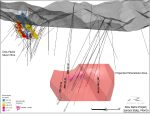
ElectraLith, a lithium technology startup backed by Rio Tinto (ASX:RIO), is set to secure a significant funding round worth AUD 27.5 million (USD 17.9 million) within the coming week, according to its Melbourne-based CEO. This comes as the global lithium market grapples with fluctuating demand and pricing challenges.
“The lithium market is not great, venture capital markets aren’t great, (so) the fact we are about to close this round with an oversubscribed investor base … for us that’s fantastic,” CEO Charlie McGill told Reuters in an interview.
ElectraLith has developed an innovative direct lithium extraction (DLE) technology, which could revolutionize lithium production in resource-limited areas like Chile’s Atacama Desert. Unlike traditional methods that rely on water-intensive evaporation ponds or open-pit mining, ElectraLith’s DLE-R process extracts lithium from brine deposits using filtration membranes, eliminating the need for water or chemicals. The process consumes minimal energy and reinjects the remaining brine back into the aquifer, addressing environmental concerns often associated with lithium mining.
The technology’s scalability remains a key focus for the company. CEO Andrew McGill emphasized the importance of maintaining membrane properties during large-scale projects, which the company plans to address using the new funds. The upcoming funding round will support the construction of ElectraLith’s first pilot plant at Rio Tinto’s Rincon operations in Argentina. The pilot plant is expected to be operational in about a year, with two additional pilot plants planned thereafter.
ElectraLith’s technology could offer a significant cost advantage. By producing lithium hydroxide directly without the need for water or chemicals, the company claims it can achieve production costs at nearly half of its competitors. This positions ElectraLith as a potential game-changer in an industry projected to grow to over USD 10 billion in annual revenue within the next decade.
Several other companies, including Exxon Mobil, are also vying to commercialize DLE technologies. DLE is poised to transform the lithium market by significantly reducing production times. While traditional methods can take months or even years, DLE can cut this down to mere hours or days. This efficiency, combined with the environmentally friendly aspects of ElectraLith’s process, could drive significant adoption in the industry.
ElectraLith’s ownership structure includes venture capital firm IP Group, Rio Tinto, and Monash University, where the membrane technology was initially developed under the guidance of Professor Huanting Wang. The company has also expanded its reach to the United States, collaborating with Australia-listed Mandrake Resources on a project in Utah. Here, the scarcity of water, compounded by competition for resources in the Colorado River Basin, highlights the advantages of ElectraLith’s water-free process.
McGill underscored the strategic edge offered by their technology in such regions. “The availability of water in areas with lithium mines is a major problem,” he noted. “In Utah, for example, water from the Colorado River basin is already allocated to cities like Las Vegas and Los Angeles. You can’t get a water permit. So we show up and say, ‘We don’t need water.’”
ElectraLith’s ability to bypass water dependency could reshape the dynamics of lithium extraction, particularly in arid and water-stressed areas. By addressing these environmental and logistical challenges, the company is positioning itself as a key player in the evolving lithium market.
The successful commercialization of ElectraLith’s DLE technology could significantly increase Rio Tinto’s efforts to expand its footprint in the lithium sector. With global demand for lithium-ion batteries continuing to grow, driven by the electric vehicle (EV) market and renewable energy storage solutions, innovations like ElectraLith’s may prove critical to meeting these needs sustainably.




 Follow us on Twitter
Follow us on Twitter Become our facebook fan
Become our facebook fan










Comments are closed.